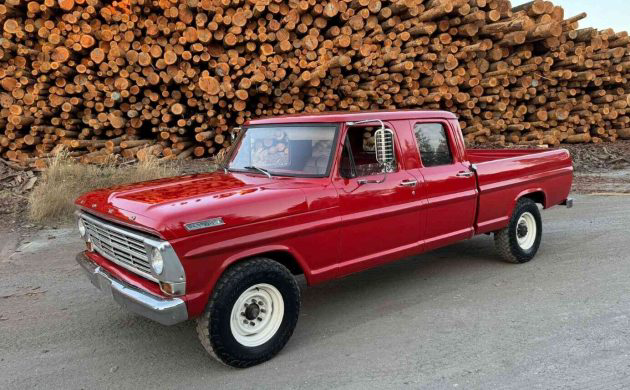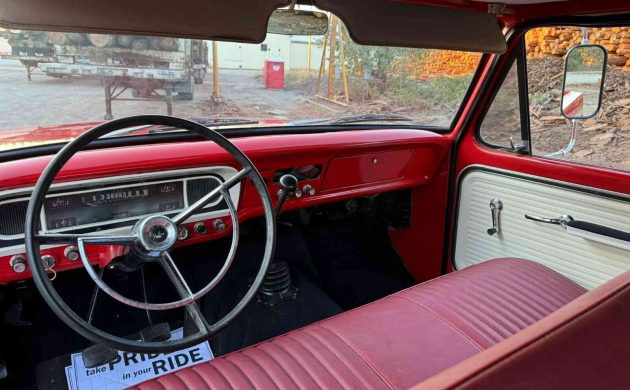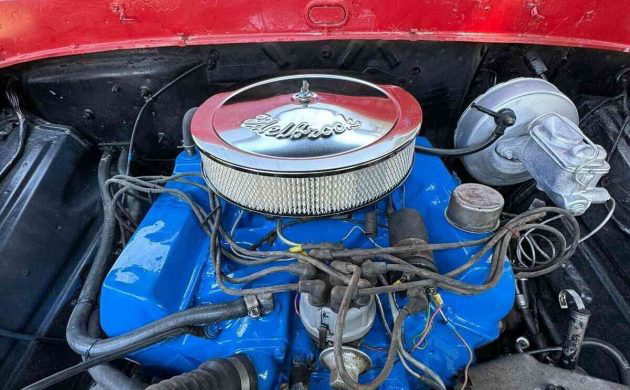Before a full-sized 4×4 pickup was necessary to transport two kids and a soccer ball to after-school practice, crew-cabs were mostly fleet-ordered work trucks. They lived a hard life and most saw random and sometimes-deliberate abuse and damage before retiring in an early grave. Until recently this fine-looking 1967 Ford F-250 Crew Cab led a similar life, still serving a landscaping company with a utility box on the back. The current owners rescued it from its intended purpose and created what you see here: a mostly stock four-door rear-wheel-drive F-250 with a freshly-sourced short bed. The original engine worked so, after a tune-up, an original-color paint job, and some interior work, it’s searching for a new home.
Model year 1967 marked the first year of this popular F-series generation, and the dashboard is pure early ’60s compared to some cars of the day. Most would hold that there’s nothing wrong with a painted metal dashboard in a work truck. The same goes for the manual transmission and mile-high shift lever. Chances are the lowest gear is a “stump-puller” that won’t see much use in daily driving, leaving three road gears. One might question the close-but-no-cigar upholstery color, but this maroon vinyl looks serviceable and altogether truck-like.
A truck in its natural habitat… close proximity to a heavy load. Beefy tires look ready for anything. Who needs four-wheel-drive and monster meats when some deep lugged light truck tires and 2WD will handle anything you’re likely to encounter?
The 352 cid (5.8L) V8 comes from Ford’s FE line, sharing design and appearance with vaunted mills like the 390 and 428. This one got a full soaking in Ford Corporate Blue that first brightened engine compartments in model year 1966. A similar treatment in what looks like “chrome” doused the boosted brake master cylinder.
If you want to make your coil springs NOT work, simply add aluminum blocks like these between the coils. The new owner will do themselves a favor by removing them and sourcing correct replacement springs. Note the twin I-beam independent front suspension and heavy dual-piston calipers up front. Count on those monsters to slow things down when that minivan jets out in front of your full load of future soccer stars and a cooler in the back. If this Central Point, Oregon classic has the right stuff for your crew, check out the listing and cast a bid here on eBay. At least eight bidders have the market value over $8000 with about a week left. The nicely-rendered paint and interior work elevate this flip above the bare minimum, and it could very well end up back in the service of a company wanting something nostalgic and memorable to wear its name on the side. Few trucks will be cheaper to keep on the road, so it’s not crazy to think someone fed-up with CAN bus sensors and the like would snap up this turn-key ride and daily-drive it. I’d consider it! The frame, powertrain configuration, and suspension components are essentially the same as a truck you would buy today. Traction control and brake modulation lie firmly in the feet and reflexes of the driver, but today’s tires are light years ahead of 1967 treads. Besides, traction control and ABS won’t help that bald-tired $80,000 SUV beside you when things go pear-shaped. Do you see the next owner giving this red rider a life of anything but leisure?







Fun write-up Todd. I got a chuckle out of “mile-high shift lever” and “minivan jets out in front of your full load of future soccer stars.” You know how some of us have old-and-new versions of some particular car or model? Who would have thought that this hard-working crew cab Ford would qualify as the “old” version aside your modern 4-door pickup. I can see it in this role; I can also see it remaining a work truck, for example as a tow vehicle for a yard crew. Just beware, it will ride and drive like an old truck…..
Thanks, Bob_in_TN! For some reason I can’t +1 your comment but here’s a personal +1. I’m currently of the mindset that I won’t buy another vehicle that has more than one computer (late ’90s to mid 2000s) so I have a soft-spot for a truck like this. For daily duties it should be completely gone through replacing springs, shocks, anything rubber, and nearly everything relating to brakes. I don’t think the F250 would be too harsh, basing that on my ’85 F250 4×4. You might even soften the springs to suit less severe duty. I value proactive forward-thinking driving more than reactionary computer safety systems, but I suppose both are the safest combination. Thanks for your comment as always! -Todd
When early crew cabs pop up they sell for ridiculous money, it will be interesting to see how high this one goes.
Steve R
Sold for a high bid of $28,600.
Steve R
I am sure there are other ways but back in the day the only way I could tell a 67 from a 68 was the heater controls
Grill was a bit different…as were the inner door handles.
’67 had no side reflectors from the factory.
Actually the 67’s did indeed have side reflectors (not lamps) on the rear bed sides from the factory. A business partner has a nice bone stock 67 F100 that has the reflectors on the bed only.
“Who needs four wheel drive…”. I sold fire apparatus for many years. Most of my clients were in the Federal Government, but I also had many municipalities and volunteer departments as clients. A lot of them felt that four wheel drive was mandatory on their new wildland apparatus. Besides being about a $25,000 up charge over a 4×2 chassis (Navistar), plus the added maintenance (which in some small towns was difficult to find qualified techs), I found that having four wheel drive gave some operators a false sense of invincibility, leading to apparatus needing to be dragged out of the mud by a bulldozer (often damaging the vehicle) because they got in over their head. Many times, I suggested a 4×2 chassis with a rear locking differential. I never had a Chief tell me that it was a mistake. 99% of the time, that set up did the job.
My story has a similar theme. My dad worked for a ma-and-pa oil company in the low-rent oil fields of (very) rural southeast Ohio. One way to save money was that the lease roads were not maintained as all-weather. Further, the owner’s policy was to buy only basic two-wheel-drive pickups. The reasoning, as simplified to me by my dad: “four-wheel-drive just means you get farther in before you get stuck.”
The practical outcome was, he did lots of walking. When something needed fixed which required more than hand tools, well you just waited for the roads to dry out.
great road crew, fence, line man, cement, etc truck. Not so much for the estate. Might even fit for lrger fam w/their camp trailer (travel trailer whatever U call it). For that I’d want a lrger motor. We put a 12v in ours. But…
It needs to be the nxt gen for my interest…
I had a supervisor who told me to always drive in 2 wheel drive until 4 wheel drive was needed to retreat.
Okay, I enjoy the authors posts, but a little off this time. 2wd pickups are incredibly inept, they can get stuck on wet grass. 4 door pickups of this era, were almost always destined for a construction or maintenance crew ( hence Crew Cab) and headed out to the forest, and 4wd is mandatory. Not sure the original purpose of this truck being 2wd. Some of these did make it into the private sector, I think I remember seeing 1. Transmission is called a “compound low”, I’ve always disliked the “granny” implication, and in 90% , 1st gear went unused. Just a couple nit-pickers, the stick is a PITA, the motor will average maybe 10 mpg, the twin I beam front, while an improvement over a solid axle, was not without its problems, still a kingpin steering, and tough, but not known for its superior ride. Nice truck, clearly restored because of the 4 door pickup craze currently going on. Someone is in for a rude awakening on the test drive, if they get it out of the driveway, that is.
Thank you Howard – you’ve had more trucking experience than I have. I based my comments on experiences with ’70s F-Series and GM 2WD farm trucks and my ’85 F-250 4×4 which was manual (Creeper + 3 road gears, the top one being overdrive — talk about WIDE ratio). Nearly all the farm trucks in PA were 2WD (to save money and complexity) and we did quite a bit of off-roading. One time we drove a RWD ’70s 454 Trailering Special a mile or more down and back up a creek bed just counting on the posi rear and the deep-lugged farm tires. I liked the stiffer 250s because they cornered better, and with the suspension parts in good order they’d take a set of RR tracks without much noise or drama. The 150s were more comfortable on and off-road. I always respect your opinion. It’s interesting how your experiences and mine were not the same and thus our opinions differ – that’s always true and people forget sometimes and think their personal opinions are, naturally, common sense. Thanks again and keep on Truckin’. -Todd
Pop’s always drove 2wd F150’s. He worked for a steel mill, and every October, he’d get a load of slag in the 8ft. bed. Never got stuck in our northeast Ohio winters. And we had some doozzies in the late 70’s. In the spring? The slag went right into the gravel driveway. Worked like a charm.
I would do this.Go through it, and add AC it’d be perfect.